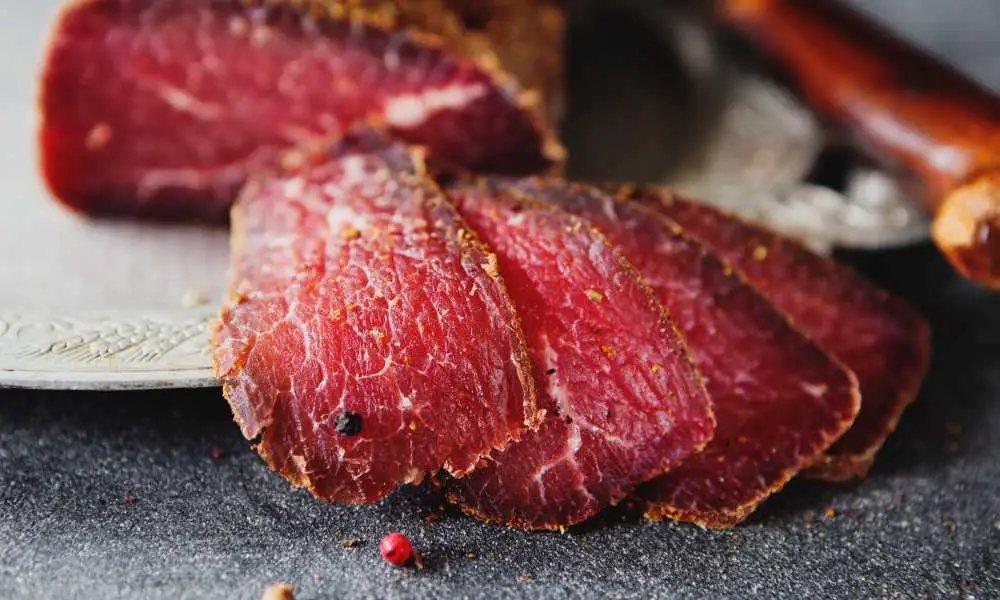This post contains affiliate links. As an Amazon Associate I earn from qualifying purchases
When it comes to making jerky, one of the first questions that arise in everyone’s mind is “How thick do you cut meat for jerky?” This question is important in the sense that the type of cut, which you’re going to make on the meat, is going to decide the quality of your end product.
You just cannot make jerky if you are not sure about the ideal cut of meat which you’re going to use for this purpose. So once again, how thick do you cut meat for jerky? And what are the different types of cuts that can make delicious tasting jerky?
In order to answer these questions, we’ve prepared this guide for jerky lovers who want to make no compromise on their food quality. We will discuss the different types of cuts and give you an idea how to make a perfect meat jerky with your affordable meat slicer.
Table of Contents
How Thick Do You Cut Meat For Jerky?
For making jerky, always cut the meat in such a way that it should contain the minimum possible amount of fat after getting processed. This is because fat tends to have a negative effect on your jerky’s taste. It will also make your jerky rancid so always select a leaner meat for making jerky.
Another disadvantage, which is usually associated with a fatty meat, is the fact that it will prevent the jerky from getting dehydrated in an easy manner. You’ve had to spend a considerable amount of time, just to remove excess water from your meat, which isn’t a suitable option for all those people who’re looking to make pounds and pounds of jerky every single day.
Hence, ask your butcher to remove any amount of visible fat. Afterward, slice it into thin pieces, in such a way that it shouldn’t be more than a quarter of an inch thick. However, if you’re going to slice it yourself, you might want to place the meat in the freezer for up to 45 minutes. This way, you can easily slice the frozen meat without any hindrance.
Different Types of Cuts
There are five different types of cuts which are usually preferred when it comes to making jerky. Starting from the eye of round, it consists of flank steak, bottom round and finally, ground meat.
Each one of these cuts is famous for making delicious jerky and depending on your personal preference, you can choose any one them.
Eye of Round
The eye of round is extracted from the rear leg, and it is one of the most popular cuts when it comes to making meat jerky. It is basically a single oval muscle and, as compared to almost any cut, this one comes with the minimum amount of fat.
In fact, it is a lean cut that if properly improvised, you don’t have to remove anything else from the meat apart from the fat caps. Even if you want to tenderize, you can do it pretty easily without spending a lot of time. As a result, if you’re looking for a flavorful jerky, you might go with the eye of round.
One thing which you have to keep in mind while purchasing this type of cut is that it usually comes at a decent price tag. So if you’re a budget-oriented shopper, you might want to purchase it during a sale before freezing it for a considerable amount of time.
Bottom Round
Extracted from the external muscle of the upper back leg, the bottom round cut is ideal for those who are looking to make delicious-tasting jerky without spending too much. It features a relatively leaner shape so if you’re tight on your budget, you can make this purchase without burning a hole in your pocket.
Having said that, the bottom round cut does come with some amount of fat cups. So after purchasing this type of cut, you have to cut away all those caps at your own home. Such cut might also contain interior marbling so you have to be extra careful when purchasing a bottom round cut from today’s market.
Top Round
As evident from its name, the top round cut can be termed as the exact opposite of the bottom round. This type of cut is normally extracted from the internal back leg muscle and, as compared to the aforementioned cut, this one contains a higher amount of tenderness.
So if you cannot afford to spend heavily on the eye of round, but don’t want to purchase a less tender bottom round cut as well, you can purchase a tenderer top round cut at a reasonable price tag.
Flank Steak
This type of cut is preferred by customers who can afford to pay for a great tasting jerky. Extracted from the underbelly portion, the flank steak cut is famous for its extravagant flavor.
This is due to the reason that as compared to a majority of meat cuts, this one incorporates the least amount of fats. Even if you’re a complete beginner, one who isn’t very familiar with the dehydration process, you can easily use the flank steak cut without hassle.
One thing you have to keep in mind while purchasing a flank steak cut is that it is usually recommended to cut it against the grain.
Ground Meat
A lot of jerky-lovers are not aware of the fact that they can actually use ground meat for this particular purpose. If you’re looking to make jerky which is easier to chew, one which won’t be too harsh on your teeth, this is where the ground meat comes in handy.
For making jerky using ground meat, you should always select leaner meat. Just cut it into thin slices, marinade it, and freeze it for a considerable time.
Having said that, the jerky which is made of ground meat won’t be as flavorful as compared to that of either flank steak or even bottom round. So if you’re looking to use ground meat for making jerky, you should always keep this thing in your mind.
See How Jerky Is Made – Put it all together
Great video courtesy of “Cooking with RY”.
Conclusion
When it comes to making jerky, it isn’t a difficult process as long as you’re aware of the optimal meat thickness and recommended meat slicers available at hand. Apart from the aforementioned guide, you can always ask help from your local butcher as he can help you cut your meat based on your preferences.


